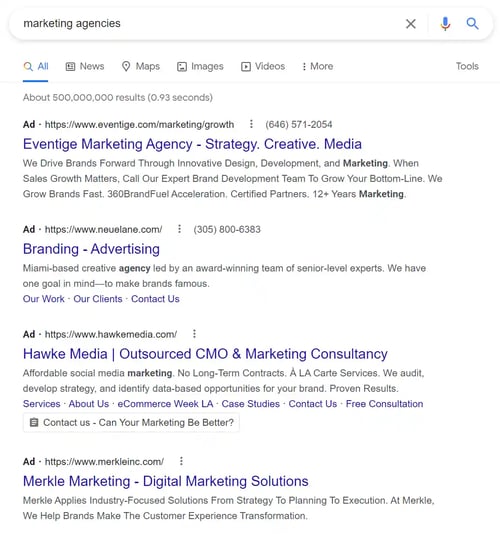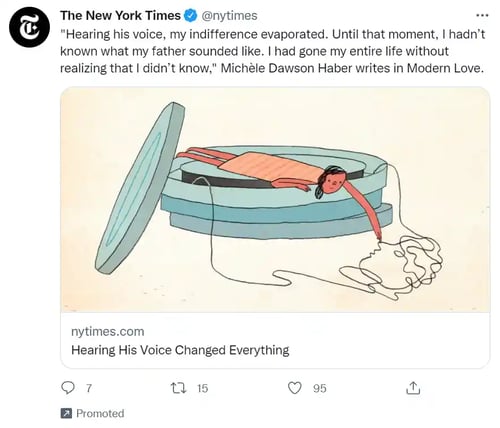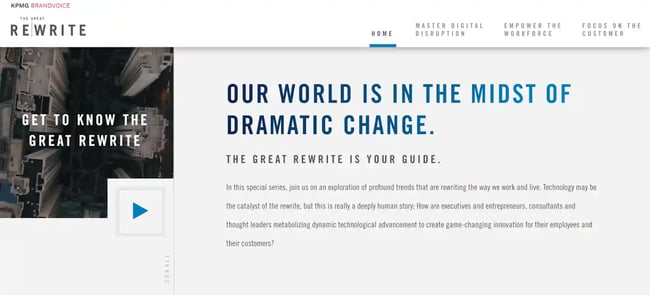You've heard it a million times, native advertising is one of the most immersive advertising experiences. But what exactly is native advertising, and why is it causing such a stir for brands, agencies, and publishers?
Native ads developed as a concept over 10 years ago and have a unique ability to evolve with media as it changes. They have since overtaken display ads as the most popular form of digital advertising.
Native advertising is a chance to put editorial expertise to work for advertisers and brands. It provides a more trusted and valuable, channel to reach readers as compared to banner or traditional display advertising.
Download Now: Free Ad Campaign Planning Kit
In this article, we’ll cover why they’ve continued to grow in popularity and effectiveness and how you can incorporate them into your marketing strategy next quarter.
What is native advertising?
Native advertising is the use of paid ads that fit seamlessly into the media where they appear. They blend in to match the content so that they don’t disrupt the viewer’s experience. In this way, advertisers can post content that hooks viewers’ attention by not being an obvious ad.
How do you spot native advertising?
A lot of social media sites will use 'in feed' native ads that you can only spot by the text 'sponsored' or 'recommended' somewhere above or below the post or profile. Blogs and websites will often put content recommendations below an article you’ve just read.
A small icon is also an indicator, often a small “s,” that if you click on it will indicate that the content is a paid ad. Google search results often include native ads in the form of listings that appear at the top or in the sidebar. The nature of native advertising is that it doesn’t stick out like a sore thumb as the ad. So, the signs are often more subtle than traditional ads.



Native Advertising vs. Content Marketing
The purpose of native advertising is to blend in and not disrupt the viewer’s experience with the given content and media. Native ads engage new audiences through a third-party with an established audience. It’s a method for distributing content, rather than the content itself. This might sound similar to content marketing, but the goal differs.
Content marketing is content that lives on your platforms, such as your website or social media pages. The purpose of this content is to build a following, grow a reader base, establish yourself as an industry expert, build trust with your audience, demonstrate credibility, increase engagement, improve sales, or all of the above.
10
- Altran Engineering in the Financial Times
- Land Rover — A Mini Suspense/Action Movie
- Eni Energy on CNN
- Mercedes in The Washington Post
- Viral Meme on VentureBeat
- Allbirds in The New York Times
- Influencer Promotion on BBC.com
- Colored Corn on Business Insider
- KPMG on Forbes
- Orbit Gum on CollegeHumor
1. Altran Engineering in the Financial Times
This native advertisement combines some of the best elements of digital advertising: video, a human interest story, and classy hi-tech with an Elon Musk connection.
Produced by the Altran engineering company, and published in the Industrial Tech section of the Financial Times, the above video, "Hyperloop: designing the future of transport?" tells the story of a group of students from the Technical University in Valencia, Spain who are competing in the 2018 Hyperloop Pod Competition run by Musk's SpaceX company.
This native video ad has a palpable human component — the students and the Altran staff who are supporting them in the tough competition. This brings in its futuristic aspect — the best and the brightest working to design the fastest transport pod that will transform the future of transportation. And it's presented as a news story, not as a promotion or ad for Altran or the SpaceX competition (although it's actually promoting both).
What Stood Out
This video has a high production value, making it a high-quality native video ad. The compelling narrative it provides also strongly pulls viewers in and gives them a story they want to engage with.
2. Land Rover — A Mini Suspense/Action Movie
Land Rover uses diverse outstanding content marketing campaigns to promote its vehicles. These native content strategies are in full form in Land Rover's Dragon Challenge video, shown above. It's eye-catching, slick, and suspenseful. It's everything a native campaign can and should be.
This nail-biting ad shows the world's first attempt to scale the stairs leading to the Heaven's Gate landmark in China — by vehicle. A specially fitted Range Rover SUV successfully drove up the 999 steps to Heaven's Gate, at a frightening angle of 45 degrees.
What Stood Out
This native campaign perfectly captures the brand essence of Land Rover — daring, excellence, adventure, and ultimately, success. Promoted via social Land Rover's networks, it's much more than an ad. It's a record-breaking event and a story of its own.
3. Eni Energy on CNN

Here's an example of graphic, luscious storytelling, ripe with green landscapes, promoted by oil and energy conglomerate Eni. It focuses on the Green River Project in the Niger Delta, an Eni development program for farming and livestock to improve the livelihoods of local communities. The campaign is promoted with native ads on CNN.com, linking back to the Green River Project. It's a truly impressive example of native content.
The site is designed as a story, divided into three sections: Past, Present, and Future. The content is a mix of just about everything — text, imagery, audio, video, personal stories, animations, and illustrations. The complete look and feel is reflective of an environmental agency, rather than an oil company.
What Stood Out
In this native campaign, Eni succeeds in distancing itself from the criticisms faced by energy conglomerates. They also manage to create a brand image as a 21st-century social and environmental force for good, and a beacon of corporate responsibility.
4. Mercedes in The Washington Post

This native campaign by Mercedes is an example of smooth, clean content designed to pique interest and engage the user. The campaign is called "The rise of the superhuman," and it focuses on various technologies that are turning people into "superhumans," such as robotic exoskeleton suits, virtual reality in medical settings, and the Mercedes Benz E-class series that integrates the new Intelligent Drive system.
The native content above is highly interactive, featuring quiz questions and hot spots the user can click to get more information. But one of the best things about this campaign is how it effortlessly creates a connection between Mercedes and the "superhuman." It's reminiscent of one of the oldest native examples, the "Penalty of Leadership" ad by Cadillac, which enhanced the Cadillac image as a prestigious leader. That simple print ad, published in 1915, is credited with reviving the Cadillac brand and boosting flagging sales that plagued the company at the time.
What Stood Out
The major draw of this native ad is the powerful connection it creates between the car and the concept of cutting-edge excellence. It establishes Mercedes as a company that is about more than just crafting cars.
5. Viral Meme on VentureBeat

Nothing beats a viral meme in terms of sheer stickiness, and it's a great way to promote brand awareness. Recently, during the famous "Laurel or Yanny?" dispute, we saw VentureBeat take advantage of the meme in native content to promote the upcoming Transform conference on artificial intelligence and analytics. How? By using an artificial intelligence (AI) device to settle the dilemma of Laurel versus Yanny, once and for all.
VentureBeat promoted an article that briefly describes how AI was used to determine whether the stated name was Laurel or Yanny. The native article discusses some of the problems that arose, and how the engineers had to adjust the algorithms to get an accurate result.
What Stood Out
Using a viral meme is a smart move because it capitalizes on a large audience that already exists. It’s attention-grabbing and exposes you to a wider pool of viewers.
6. Allbirds in The New York Times
Special articles in The New York Times focus on creating an experience, not just a story. This is a great opportunity for native advertising to come into play. This paid post, The View From Above: Why Our Future May Depend On the Fate of Birds, was placed online and sponsored by the shoe company Allbirds. This example was placed as an in-feed/in-content ad on the platform’s newsfeed.
The article is about how valuable birds are to our environment and the ways climate change is putting them at risk. Allbirds as a company has a major focus on sustainability, and, obviously, has “birds” in its name. The post’s beautiful animated graphics and soundtrack of bird sounds create an awesome experience for viewers that also promotes the company.

What Stood Out
The format of native advertising is at its best when the media can align with the brand. Allbirds being able to create an experience about sustainability promotes not just their product but also their priorities as a company.
7. Influencer Promotion on BBC.com
BBC Future is one of the BBC's "storytelling" channels, which connects brands to audiences via sponsored stories. An interesting example is this BBC article, which purports to show the face of the "average American politician."
In fact, this is achieved by using technology to perform "face averaging," creating composite images of all American politicians to derive the average face.
This technology can lead to all kinds of research and suppositions about what the average politician represents, including gender, race, republican, and democrat — all hot topics in a highly politicized time period.
The article ends with a call-to-action (CTA) to learn more about face averaging with an online tutorial on OpenCV, an open-source computer vision software. The link leads to a website owned, not by a large corporation or software giant, but by an individual entrepreneur, programmer, and blogger: Satya Mallik.
What Stood Out
In this example, we love how native advertising is accessible to small businesses and influencers, affording powerful promotion opportunities on premium websites like the BBC.
8. Colored Corn on Business Insider

One of the best native tactics is creating a story. And if the story is visual and colorful, well, that's a huge help. Take this example of native content promoted on Business Insider.
The example above looks and feels just like a regular Business Insider article. It's about Glass Gem Corn, a multi-colored corn variety that became a public sensation in 2012. It's the story of one man and his search for his Native American roots that led him to develop the colored corn. And in true Business Insider fashion, the story of the rainbow corn is retold in amazing, bold, eye-catching visuals.
The article contains links to buy the seeds online from Native/SEARCH, a not-for-profit conservation company that now owns the product. So what's in effect a product sales page is presented as a remarkable, colorful news story.
What's most interesting about this article is the disclaimer published by Business Insider: "This article was originally published in 2013 and has been updated because the story is timeless." It just goes to show: Evergreen content promoted natively can truly be a long-term success story.
What Stood Out
Crafting a story that is fun, interesting, and promotional is a great way to format a native ad. This also has the benefit of being attached to a viral story, making it even more effective.
9. KPMG on Forbes

Forbes' BrandVoice is a platform for native advertising and sponsored content. Many brands have their own BrandVoice channels, such as Mitsubishi Heavy Industries, SAP, Deloitte, and even the government of Japan.
KPMG has taken its native content on Forbes to the next level, with a campaign called "The Great Rewrite."
Big and bold (just like native advertising should be), The Great Rewrite focuses on different industries and how they are being "rewritten" in a post-innovation age. The campaign look and feel is grand and ultra-modern, yet easy to navigate.
What Stood Out
This native ad connects KPMG with the future of innovation, while continually adding new "chapters" about various sectors. Each chapter is packed with content, including video, featured articles, and content recommendations. This is a great example of a native campaign that, just like its title, is rewriting the rules of native in an ongoing, ever-growing, content-rich user experience.
10. Orbit Gum on CollegeHumor
Videos make great native ads because the entertainment value makes it easy to blend into traditional media. “Dating Footnotes” presented by Orbit was released ahead of Valentine’s Day on the popular YouTube comedy channel CollegeHumor. It’s short, funny, and capitalized on the holiday of the time.
Orbit has a history of fun, memorable commercials, so a native ad like this fits perfectly into their branding. This native ad also blended well into the humor of the channel where it’s posted and was able to promote Orbit Gum’s products without feeling like a regular commercial.
What Stood Out
Humor and creativity go a long way when it comes to advertising. This, plus the real-world application of a product, like gum on a first date, makes for a memorable and effective native ad.
Native Ads Have Great Potential
These days, many native ads that we see online are truly spectacular. Some are eye-catching, others are original, and yet others offer inspiration for new ways to promote compelling content and capture mindshare.
The nine examples give a taste as to how native advertising is constantly advancing, pushing the boundaries of content and design to create new, unexpected online brand experiences.
Editor's note: This post was originally published in June 2018 and has been updated for comprehensiveness.
Advertising Examples
.png?width=112&height=112&name=Image%20Hackathon%20%E2%80%93%20Horizontal%20(19).png)










.jpg)


![The Most Annoying Types of Ads & What to Do Instead [New Data]](https://53.fs1.hubspotusercontent-na1.net/hubfs/53/most-annoying-ads.jpg)
![5 Brands That Won Australian Advertising Awards [+What Marketers Can Learn From Them]](https://53.fs1.hubspotusercontent-na1.net/hubfs/53/australian-advertising-awards.webp)